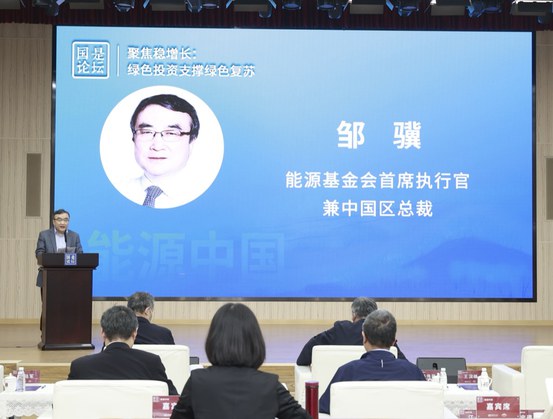Experts Discussed How to Drive Decarbonized Growth With Green Investment
On April 25, 2022, China News Service and Energy Foundation China (EF China) held another event of their signature Sustainable Energy for a Prosperous China forum series in Beijing with both online and offline participants. Themed with green investment and recovery, economists and energy experts at the forum discussed on how to achieve high-quality growth, low carbon economic development, and energy transition against the backdrop of the COVID-19 pandemic.

Ji ZOU, CEO & President of Energy Foundation China, addressed the Sustainable Energy for a Prosperous China forum on green recovery on April 25, 2022, in Beijing.
Photo by China News Service
Lujun CHEN, President of China News Service, and Ji ZOU, CEO & President of EF China, delivered opening speeches. Mr. CHEN said that ensuring a steady growth did not mean a return to the old path; instead, China should shift its growth drivers under the framework of high-quality development and explore the great potential of green investment.
According to Ji ZOU, the once-prevailing concept that the objectives of affordable, secure, and clean energy could not be achieved at the same time was obsolete, and climate change and environmental efforts should not be set against economic development. He said that China was ushering in a new era of industrial revolution featured by energy and technology breakthroughs, when policy objectives for economic growth, energy security, environmental improvement, and climate safety could be aligned with a new development concept and shorter- and longer-term goals could be linked. Accumulative direct investment toward carbon neutrality could reach at least 140 trillion RMB ($21 trillion) in China by 2050, suggesting that such investment would to a large extent drive the economic growth during the 14th Five-Year Plan period and over the next three to four decades. Economic growth and China’s transition to carbon neutrality were organically integrated, said him.
In his keynote speech about economic growth and consumption, Weimin YANG, Member of the Standing Committee of the CPPCC National Committee and Deputy Director of the Economic Affairs Committee, said that facing the economic and environmental challenges amid a pandemic, China should seek dynamic equilibrium among the multiple objectives of carbon peaking and neutrality, economic growth, and human health.
Hanfeng WANG, Chief Strategist and Managing Director of the China International Capital Corporation, talked about emerging trends in green investment. He said that from now to carbon neutrality, China would need $20 trillion for green investment by 2060, accounting for nearly 2% of the annual GDP. The electricity sector had the highest $10 trillion demand for green investment, followed by transportation and buildings, according to him.
During the panel discussion session, guest speakers discussed on the key areas of green investment.
Junfeng LI, China Investment Partner of Sequoia Capital and Director of Sequoia Carbon Neutrality Research Institute, said that the gradual energy transition in China would require efforts in five areas: shifting the policy focus as soon as possible from curbing total energy consumption to capping total fossil fuel consumption; facilitating a coal peak as early as possible; controlling coal-fired power development; integrating non-fossil generation into the power system; and adopting enabling policies.
Yi JIANG, Academician of the Chinese Academy of Engineering, said that investment should be made in three areas: new power distribution systems for urban buildings and intelligent charging piles for electric vehicles; new rural energy systems that can transform villages from energy consumers into producers of zero-carbon energy, including using roof photovoltaic panels; and the recovery of industrial waste heat for space heating and for production.
Denian SHI, Deputy Chief Engineer of the China Academy of Information and Communications Technology, was focused on three trends in China’s manufacturing industry, including digitalization and intelligentization, carbon peaking and neutrality targets and green development, and the domestic cycle of economic activities and supply chains. He said that with the carbon targets, investment opportunities should be highlighted in the industrial chains featuring low carbon energy, energy storage, and energy efficiency.
Xiaoshi LIU, Executive Deputy Secretary-General of China EV100, said that the new energy vehicle industry could be a pioneer for China’s economic transformation, as it had significantly driven the economic growth.
Hong YIN, Vice President of the Modern Finance Research Institute of the Industrial and Commercial Bank of China, said that carbon neutrality would bring investment demand of hundreds of trillions RMB, of which 80–90 percent would be in four industries: energy, buildings, transportation, and nuclear power. The investment demand for the energy industry would come from cleaner power generation, end-use electrification, and emission mitigations of non-electric sectors—three aspects that financial institutions should pay closer attention to and provide support with innovative financial tools.




